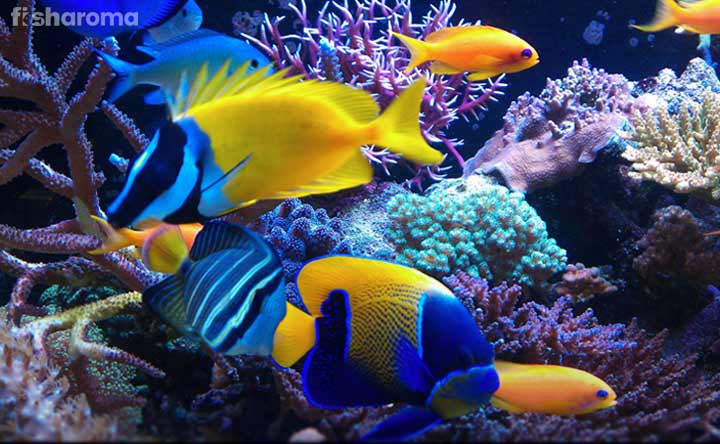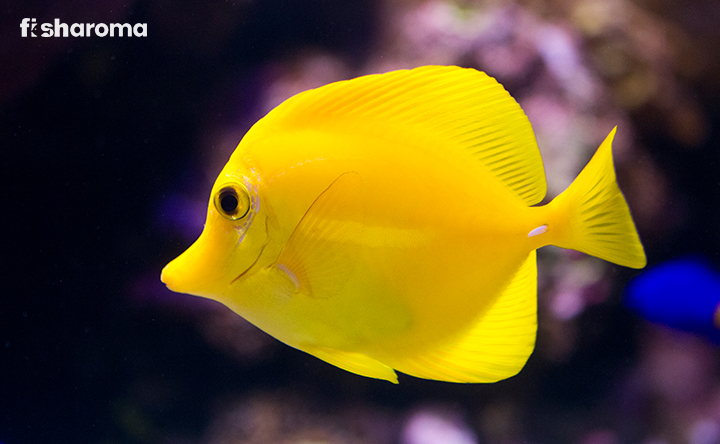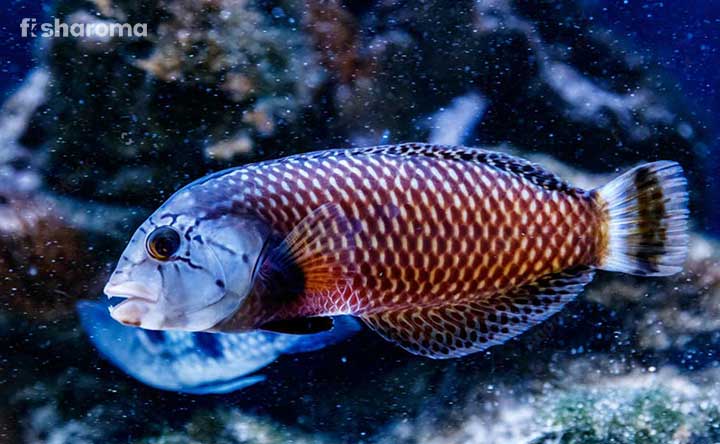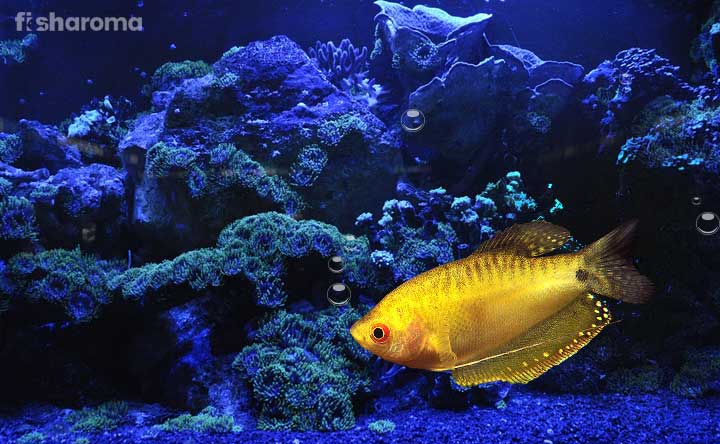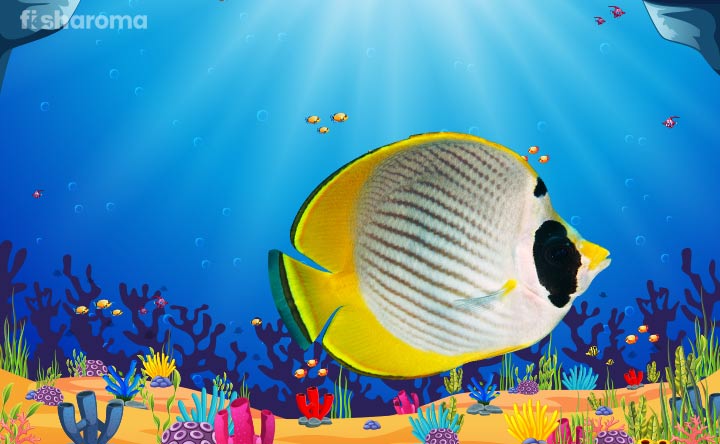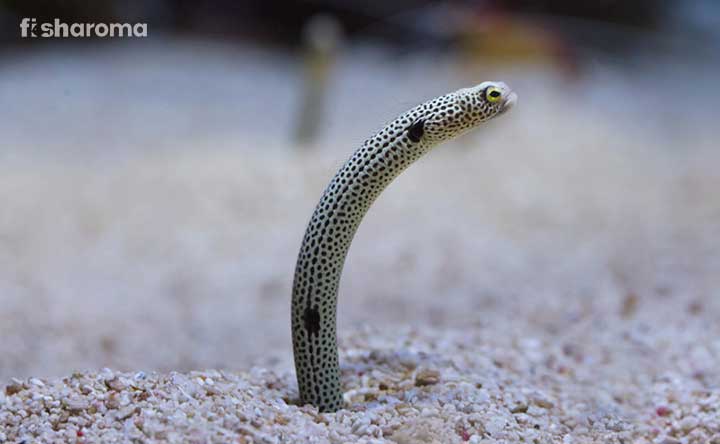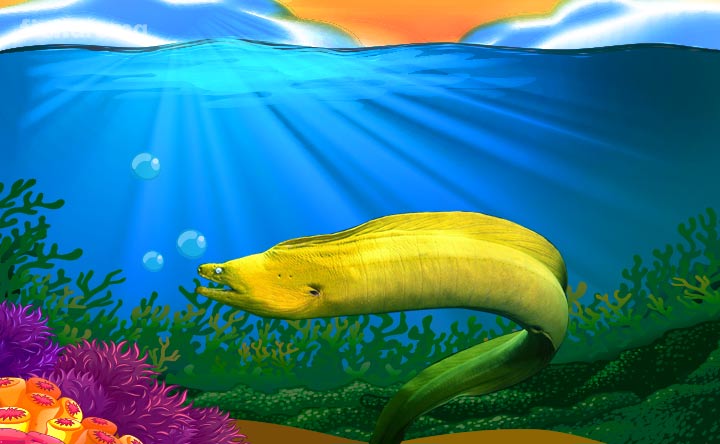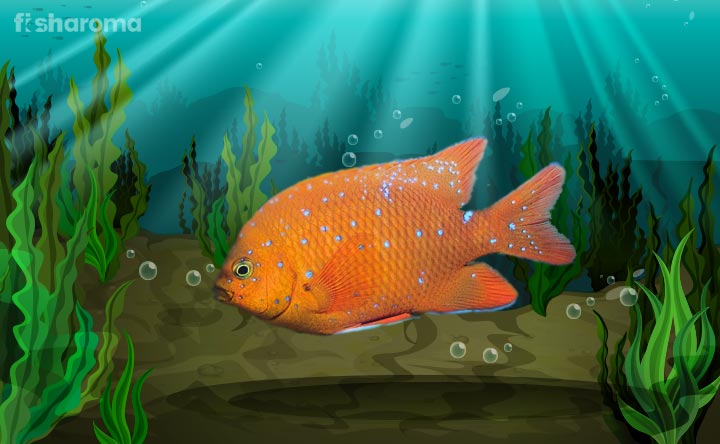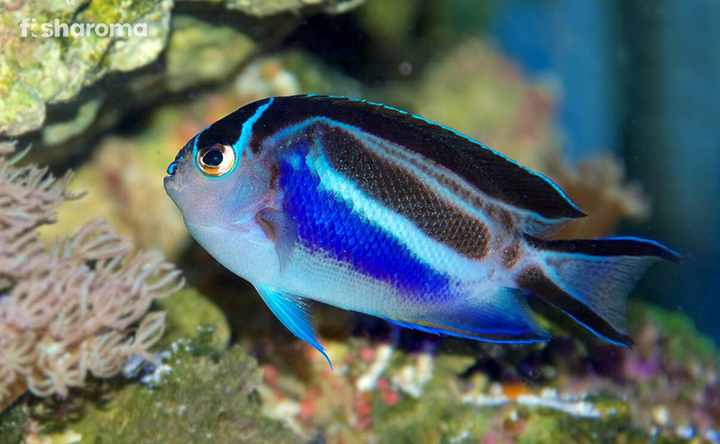Chalk Bass: A Thorough Care Guide To This Exceptionally Reposeful Saltwater Beauty
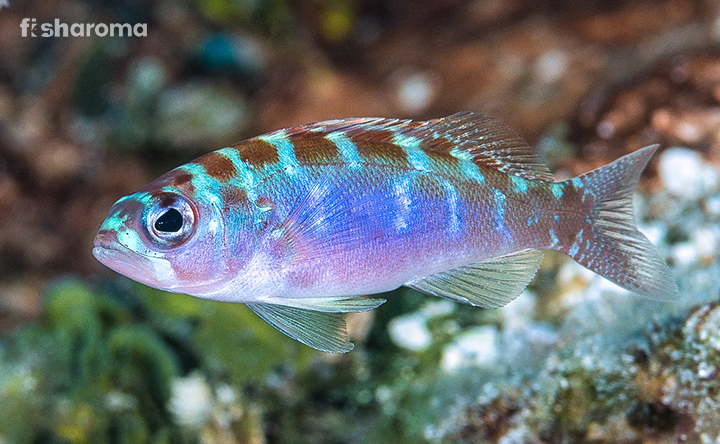
Chalk Bass, also commonly known as Chalk Basslets, are one of the smallest types of saltwater Bass fishes. These fishes are from the Actinopterygii class and Perciformes order. They are found at the bottom, near the sea bed, playing and hiding amidst the corals.
Chalk Bass are a celebrated choice among many reef aquarists. This is because they have a small size and so, it is quite easy to house one Chalk Bass or a group of them in a standard-sized tank. Additionally, the tranquil and composed nature of these fishes makes them even more famous among fish enthusiasts. Also, these fishes are totally reef safe.
Chalk Basslets are remarkably beautiful and have catchy patterns and colourations on their skins. This is also certainly one reason why Chalk Basslets are absolutely loved and admired by aquarists.
So, we guess you are here because you are indeed interested in having one as your pet? Let us assure you that in this article we will provide you with the best guidance on their care requirements, diet, breeding and more!
Key Specifications of Chalk Bass
Chalk Bass will be a treasure to your reef aquarium. You should absolutely be aware of their lifestyle, traits and requirements. In this table below we will provide you with a brief outline on the same!
| Scientific Name | Serranus tortugarum |
| Origin | Atlantic and Caribbean Sea |
| Lifespan | 1-2 years |
| Colour | Orange and Light Blue |
| Temperament | Peaceful |
| Size | 4 inches |
| Diet | Carnivore |
| Family | Serranidae |
| Compatibility | Peaceful and other similar-sized fishes |
| Tank Size | 20-30 Gallons |
| Care Level | Easy |
| Water Temperature | 22.2-25.5 Degrees Celsius |
| Water Conditions | pH 8.1-8.4 |
| Breeding | Pelagic spawners |
Overview
Chalk Bass (Serranus tortugarum) is one of the most famous types of Basslets. These fishes are a common choice among many saltwater aquarists. Chalk Bass belong to the Serraninae subfamily, a part of the Serranidae family.
Chalk Bass are very calm, silent, playful, polite and also equally welcoming of other peaceable tank mates. They have unique motifs and iridescent colouration on their bodies which surely attracts one’s attention. Besides, these fishes are beginner-aquarist friendly as well!
Chalk Basslets are bottom dwellers. They love to roam and hover around the corals, aquatic plantations and live rocks. Also, since they are shy and timid, they love to hide inside caves.
Chalk Basslets are actually quite an easy and comfortable option for many aquarists because of their size and temperament. If you are planning on getting one for your aquarium then, follow through with this article to know everything related to their care and behavioural traits.
Origin and Habitat of Chalk Bass
Chalk Basslets are native to the Atlantic and the Caribbean Seas. They are geographically distributed throughout the seas of the Caribbean and South Florida to the Bahamas and Honduras.
Chalk Basslets mainly populate the oceans at the depth of 90 meters. On the ocean bed, they live peacefully amongst the rubbles, corals, caves and live rocks.
These fishes thrive in warmer water temperatures, alkaline pH and high salinity.
Appearance of Chalk Bass
Chalk Basslets have a torpedo-shaped body frame. They have an elongated and laterally compressed body shape. Additionally, these fish have a tapering snout. They are small and slender. You’ll notice 3 spines on the fish’s gill cover, where the middle spine runs straight.
The caudal fins of a Chalk Bass are truncated. Whereas, the dorsal fin is composed of 10 spines and 12 soft rays. The anal fins, on the other hand, are made up of 3 spines and 7 soft rays.
Chalk Bass are mainly known for their unique colouration. We’ll have a look at them in the “colour” section.
Size
Chalk Basslets are comparatively quite small in size than other sea basses. An adult Chalk Bass grows up to 4 inches in length. Their size is one common reason why aquarists prefer to have them as their pets as they could easily fit in any standard-sized tank.
Colour
When it comes to colouration then, Chalk Bass are extremely unique! They have this astounding ability to camouflage themselves against their surroundings. This safeguards them from potential predators and other sorts of dangers. The colour of a Chalk Bass’s body changes depending on the angle at which the light is falling on their body.
Typically, you will see an orangish hue on their bodies, covered with electric purplish-blue stripes. Depending on the light, you may also notice a bluish hue on their bodies with burgundy stripes.
Juvenile Chalk Bass sport a dull colouration at the beginning. Later on, as they mature, the colours on their bodies change from a metallic bluish shade to a reddish-orange one.
Behaviour of Chalk Bass
Chalk Basslets are known for their pacific nature. They are great community fishes. Chalk Bass love to live together in groups. They live at the bottom of the tank and so, you will often find them hovering around the rocks, corals, caves and aquarium plants.
When a community of Chalk Basslets is formed, a dominant and a leading member is chosen by the group members. The leader fish guides the school of Chalk Bass and they work in unison to guard their own territories. It is always important that you bring and nurture a group of Chalk Basslets together so that, each one of the fishes gets along well with each other. They will be very unwelcoming of a new Basslet once the fishes have already formed a community, a hierarchy and chosen a team leader.
Chalk Bass get frightened in the presence of large, aggressive and territorial fishes. When threatened, these fishes take shelter beneath the corals. Chalk Basslets are definitely reef safe and you can undoubtedly keep them in a reef tank.
Lifespan of Chalk Bass
A Chalk Bass lives up to 1-2 years. If provided with the proper diet, care and maintenance, these fishes can survive for around 1 more year. The overall lifespan of a Chalk bass is very low.
Diet of Chalk Bass
Chalk Bass follow a carnivorous diet. The great part is, that you can feed a Chalk Bass anything! Yes, they do love meat but, you’ll also notice them munching on algae inside the tank.
One certain thing that you need to pay heed to is that Chalk Basslets are fast eaters. They will finish their meals in no time. These fishes won’t stop eating as they have a huge appetite. So, there is a huge chance that you might end up overfeeding them. This can lead to serious health issues as your Basslet might get obese. Do keep an eye on the timing and the amount of food that Your Chalk Bass is munching on.
Chalk Basslets are also known to steal foods from slow-swimming fishes. To prevent this, make sure that you are distributing the food in different portions inside the tank.
You can feed them:
- Algae
- Brine Shrimp
- Frozen Fish food
- Bivalves (chopped)
- Crustaceans (chopped)
- Mysis Shrimp
- Krill
- Squid
- Fish Pellets and Flakes
If you notice that your Chalk Bass is refusing to have food then, immediately see a doctor. It is rare for a Chalk Basslet to not eat as they are avid feeders.
You can consult a vet and also include food which enhances the pigment and colouration of the fish’s body. Also, make sure that their diet has an ample amount of protein in it. For that, you can also add protein supplements.
Tank Requirements of Chalk Bass
Do Chalk Bass enthral you?? Are you interested in having them as your pet? If yes then, you need to put effort into their care, maintenance and tank conditions. Below is an expert guide on the various tank conditions and requirements of a Chalk Bass. Get detailed suggestions on how you should set up a perfect fish tank.
Tank Size
For a single adult Chalk Bass, you should get a tank size of 20 Gallons. Now, Chalk Basslets prefer to live in groups. So, if you are aiming at it then, you should at least house three Chalk Basslets in your saltwater aquarium. For that, a 30 gallons tank is a must.
A spacious tank will allow your Chalk Bass to swim around freely, explore and find comfort in their own territory.
Tank Shape
Chalk Basslets are bottom-dwellers and so, a rectangular-shaped tank is the right choice for them. These fishes require plenty of space to swim around and they find respite hiding inside the caves and rocks at the bottom of the tank.
Tank Lid
Chalk Bass are active jumpers. They can jump off the tank when they feel threatened or stressed out. So, when it comes to a Chalk bass, you should definitely get a lid for your tank. Else, your pet fish might jump off the tank and ultimately suffocate to death.
Additionally, a tank lid will also ensure that your tank is protected from all the unnecessary foreign waste particles. Also, a tank lid will keep your fish safe from any other pets at your home.
Close the lid tightly after you place it on the tank.
Substrate
Chalk Basslets are bottom-dwellers. So, you should pay attention to choosing the right substrate type for your fish. It is recommended that you use sandy substrate for your Chalk Bass tank as they will mimic the natural reef environment of the fish.
Make sure that you add lots of rock rubbles at the bottom of your tank. These will not only help your fish relax and be comfortable, but they will also improve nitrogen cycling.
Filter
It is indeed important that you install a strong and proper filtration mechanism inside your reef tank to ensure a healthy life for your Chalk Bass.
A strong filtration technique and the correct air filter will make sure that your tank is safe from all the foreign dust particles, waste materials, toxins and unwanted chemicals like nitrates.
Additionally, they will also ameliorate air purification, oxygenation and ventilation.
Ornaments
When it comes to a Chalk Bass, don’t forget to include lots of hiding places in your tank. These fishes will feel at home if you can successfully mimic their natural environment inside the reef tank. Add live rocks, caves, stones, coral rubbles and conch shells to your tank.
Hiding places add a sense of feeling at home. These will calm your fish and help it deal with stress. They can easily take cover when they will feel threatened or uncomfortable.
Besides, these decors will enhance the beauty of your reef aquarium.
Lighting
Chalk Basslets hover around near the bottom of the tank. So, quite naturally, if you want to replicate their natural habitat then, go for subdued lighting when you are first introducing the fish to your tank. This will confer them with a feeling of security and make them feel at home.
Again, the vibrant and iridescent colouration on a Chalk Bass’s body can only be visibly enjoyed when the lighting intensities are changed. The body colours will switch to different hues according to the lighting and the angle at which the rays of light fall on their bodies.
So, yes, if you want to explore the beauty of your Chalk Bass in its entirety then, gradually increase the intensity of the light as your pet fish starts attuning to the new environment.
Presence of Flora
Chalk Basslets would love the presence of flora in their tank! You should saltwater plants to your reef tank and these include Mangrove, Spaghetti Algae, Halimeda, Sea Lettuce and Water Primrose.
These live plants will not only comfort your Chalk bass but will also increase the oxygenation and the ventilation inside the tank. Adding live plants to your saltwater tank will not only beautifully adorn the environment, but will also absorb unwanted and harmful chemicals like nitrates and carbon dioxide. They would act as a natural filter, thereby enhancing the oxygenation inside the tank.
Cleaning Methods
If you are planning on including a Chalk bass in your reef tank then, the foremost rule is to keep your tank clean. Make sure that you are changing 10% of the tank water at least once or twice a week.
A proper filtration system is a must! To further clean your tank, use a sponge or plastic/metal scraper to remove dirt and excess algae from the inside of the tank’s glass/acrylic wall. You can use aquarium vacuum cleaners to remove accumulated dirt, food particles and waste materials from within the substrate layers.
Additionally, it is recommended that you add activated carbon to your reef tank. These activated carbons purify the tank water by removing toxic inorganic and organic chemicals.
Watch whether you are taking the proper measures for cleaning your fish tank.
Water Types for Chalk Bass
When it comes to a Chalk Bass, you need to pay keen attention to the fish’s water requirements. Chalk Basslets are sensitive to even slight undesirable changes in the water conditions. So, ensure that you are well aware of their requirements.
You should fully cycle your aquarium before introducing your Chalk bass to the tank.
Water Temperature
Chalk Bass thrive the best in water temperatures ranging from 22 to 26 Degrees Celsius. Make sure that the water temperature doesn’t alter by more than 2 degrees.
You should install a good quality heater and an aquarium thermometer to make sure that you are properly maintaining and regulating the water temperature inside the tank.
pH Level
For a Chalk Bass, you should maintain the pH level from 8.1 to 8.4. Chalk Basslets require a slightly alkaline pH of water for their survival. You should ensure that you are always maintaining the correct pH level inside your tank.
Hardness
The water hardness for a Chalk Bass should be kept between 8-1 dKH. Make sure that you are paying attention to the hardness of the water as a slight change will make your fish feel uncomfortable.
Specific Water Gravity
The specific water gravity inside your saltwater tank should be maintained between 1.020-1.025. Chalk basslets are mid-level to bottom dwellers.
Compatibility of Chalk Bass
Chalk Basslets are extremely calm saltwater fishes. They are often quite welcoming of other marine creatures. However, since they are quite small in size and generally timid, they get easily intimidated by species of fishes which are aggressive, predatory and comparatively large. So, always make sure to choose the tankmates wisely. These fishes get along well with other similar sized and mild-tempered fishes.
Additionally, these beauties do very well in a community. Make sure that you are introducing the Basslets at the same time in the tank and that they are growing up together. If you introduce a new basslet to an already formed community of Chalk Bass then, there are high chances that the settler will get bullied, harassed and starved to a point that they end up dying. The community of the fishes will often fight with the newcomer, not considering the fish as a part of their team and territory.
Suitable Tank Mates
- Dwarf Angelfish
- Butterfly Fish
- Cleaner Goby
- Damselfish
- Pajama Cardinalfish
- Clownfish
- Green Chromis
- Solar Wrasse
- Fairy Wrasse
- Panther Grouper
- Starfish
- Crystal Red Shrimps
Unsuitable Tank Mates:
- Large and aggressive Basses
- Triggerfish
- Lionfish
- Hawkfish
- Snowflake Eel
Breeding of Chalk Bass
Chalk Bass breeding is a very peculiar phenomenon. Chalk Basslets are hermaphrodites and they follow the strategy known as “sequential hermaphroditism.” These fishes have both male and female reproductive organs. As they follow the strategy of sequential hermaphroditism, Chalk Basslets switch from one sex to another under certain circumstances. These include social or even behavioural stimulations. For instance, if a group loses a dominant male fish then, one of the females will switch to a male to carry out the process of reproduction.
How do they mate?
When a mating pair is formed, it has been observed that the partners show a great affection toward one another. During the mating season, they follow the ritual of “egg-trading”, that is, since both the partners in the pair can produce eggs, they take turns to lay the eggs in a scattered way. One single partner would produce consecutively two parcels of eggs before the other one switches their sex to a female and starts producing further parcels of eggs.
Although Chalk Basslets are hermaphrodites, they cannot fertilize their eggs. That is why they form a mating pair, switch sexes and take turns to lay the eggs and then fertilize them.
Are they Pelagic Spawners?
Chalk Basslets are pelagic spawners. They will swim through the current to the surface of the water and lay their eggs at the top, after which, they are fertilized by the males. The fertilized eggs then drift with the planktons in the tank and finally, they land upon the reefs, where they hatch.
Now, in this type of spawning, where the eggs are laid at the top of the tank, there are certain risks and factors that you should pay attention to. First of all, the fertilized eggs floating at the top of the tank may get stuck and suctioned in by the filters. Either this or, these eggs become an easy target for other tankmates.
How to take care of the Fries?
So, after the eggs are fertilized, you should immediately separate them into a nursery tank. Here the eggs will hatch and the fries will have a greater survivability rate.
Inside the nursery tank, the Chalk Bass fries must be given a properly nutritious diet which should include phytoplanktons, small copepods and rotifers. Make sure that you are keeping the tank water clean and that the filtration system is working well.
Do not reintroduce the baby Basslets to the previous tank where the parents stay. This will increase the chances of an attack on the babies, by the parents themselves. This happens because, as we have already discussed earlier, Chalk Bass are not quite welcoming of fishes from the same species. So, it’s always better if the fires grow up together in a separate tank.
Did you know that the sex-changing phenomena between the partners in a mating pair occur quite frequently? Scientists still don’t certainly know the reason behind this. However, according to certain notable researches conducted by scientists, they do this intending to pass on pure sets of genes to the next generation. A single fish can both act as a male and a female and so, each fish gets the chance to fertilize the eggs laid by its partner. This increases the chances of passing along the genes which would lead to a group of fries with a pure genetical trait.
Disease and Treatment of Chalk Bass
Although chalk basslets are quite resistant to many common saltwater diseases, they are not immune to Protozoan Cysts and Pop-eye condition.
Pop-eye Condition
This is a severe infection caused by certain bacteria. You’ll notice that the fish’s eye has swollen and is popping out. If left untreated for a while, the eye may further pop out causing incurable damage and ultimately blindness.
To treat this infection, first, isolate the affected fish in a separate, fresh saltwater tank. Consult a vet for suggestions on curing the disease. Meanwhile, you can feed the infected fish antibiotic food. To prevent the disease, make sure to keep the tank clean, change the water at regular intervals and feed the fish nutritious food.
Protozoan Cysts
These cysts are characterized by white spots on the fish’s body. Protozoan diseases very commonly affect Chalk Bass.
To treat this disease, you must ensure that your tank is hygienically maintained and the water is changed every once in a while. You should also install a UV system,m to kill the existing protozoan cysts inside the tank.
Summary
On a closing note, if you are indeed planning on making a Chalk Bass a part of your sweet family then, let us tell you that you have made a great choice! Getting a Chalk Basslet will be an enticing experience. Not only are these fishes remarkably gorgeous, but they also have an enchanting persona.
Furthermore, if you are just beginning with the fish-keeping hobby then, a Chalk Bass will be a good option as they are not that hard to care for. Additionally, their size and temperament will help you greatly with the fresh experience of fish-keeping.
So, are you yearning to have one or more than one Chalk Basslet in your aquarium? This article will aid with the necessary care guidelines. Go for it and enjoy spending your time watching your Chalk Bass play delightfully and live happily with other tankmates in your aquarium!
Similar Care Guides
If this article intrigues you then, do visit our site for further such articles on different types of fishes and aquatic lifeforms!
- Care Guide for Bicolour Blenny: These species of Blennies would make a great addition to your saltwater aquarium. As the name suggests, they have this unique lateral division of two different colours on their body.
- Care Guide for Firefish Goby: Firefish Gobies have elegant and eye-catchy patterns and colours on their skin. They are very calm and are totally reef safe. Why wouldn’t someone love having them in their family?
- Care Guide for Royal Gramma: Royal Grammas are one of the most sought-after saltwater species of fishes. They have a vibrant hue to their skins and their equally peaceable nature makes them even more of a favourite choice among reef aquarists.

